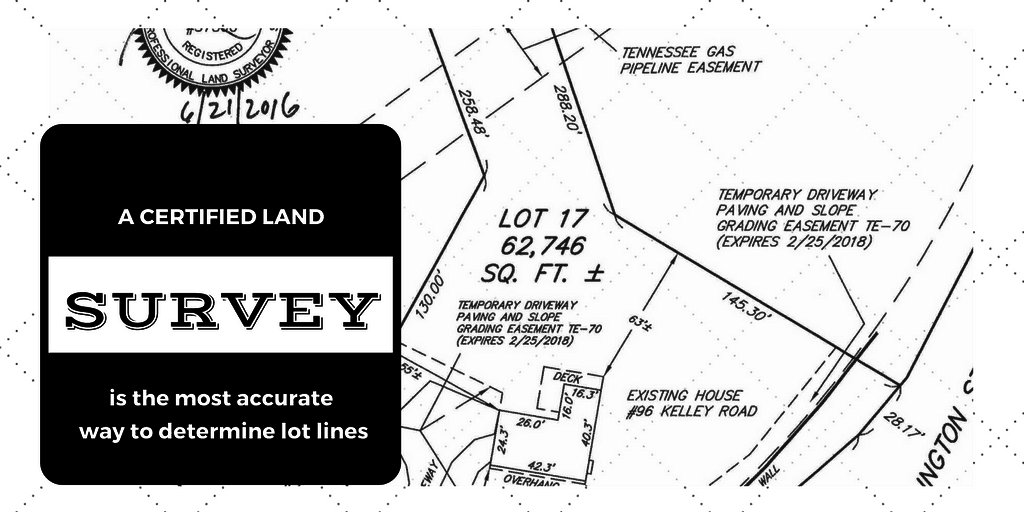 A question that home buyers often ask is, “Where is the property line” of a particular home? For many buyers and sellers, finding the property lines or boundaries of a property is essential. Of course, this is a very valid question.
A question that home buyers often ask is, “Where is the property line” of a particular home? For many buyers and sellers, finding the property lines or boundaries of a property is essential. Of course, this is a very valid question.
Nothing beats owning your own parcel of land. And nothing is more important than those invisible lines separating you from your neighbor. There are legal and financial concerns around one property line. On a larger scale, wars have been fought over boundary disputes between neighbors.
As a home buyer/owner you want to know your boundaries and rights that come from owning real estate for several reasons:
- Make sure you are not encroaching on a neighbors property.
- To know a neighbor is not encroaching on your property.
- Fully enjoy and maintain your property.
Unfortunately the answer is not as simple as home sellers and buyers would like it to be.
A Recent Dispute Involving Property Lines
I recently had a home under agreement in a Dracut Neighborhood. There had been some recent road work done that redesigned the road and some driveways.
During the home inspection, we asked the neighbor where the side lot line was between the two properties. He showed us where it the side lot line lay. Unfortunately the home my client had under agreement had a piece of the driveway on the neighbors property. The neighbor also had his own survey done to protect his interest and showed us where the offending piece of driveway was located.
As an agent representing a buyer my ears went up. The listing agent was there and assured me the neighbor was wrong. But that is not good enough. I went to the town and pulled the proposed plan done by a surveyor.
Ultimately that was not good enough, we required the seller to have an “as built” land survey done and rectify any boundary issues, if any.
In the end the seller had to move the driveway about two feet. This prevented my buyer client from having any future issues regarding the encroaching driveway.
Why Was It Important To Find Property Lines?
So two feet doesn’t sound like a big deal. But it is. The buyer didn’t even want to make an issue of it but sometimes a home buyer doesn’t know what is best for themselves. It took myself and an attorney explaining to buyer why it was a big deal.
If a title insurance company figured it out there was an encroachment, it would make both properties uninsurable in the future. If you or a potential buyer is buying a home most likely it is being financed by a bank. The bank requires title insurance that cover encroachments and clouds on the title that could effect ownership.
The driveway is an encroachment, because it crosses the boundary line and encroaches on the neighbors property. Title insurance companies will typically not lend on properties where either the property is the offending property or two if they are the property being encroached upon. The definition of an encroachment by Investopedia is:
A situation in real estate where a property owner violates the property rights of his neighbor by building something on the neighbor’s land or by allowing something to hang over onto the neighbor’s property. Encroachment can be a problem along property lines when a property owner is not aware of his property boundaries or intentionally chooses to violate his neighbor’s boundaries.
This is also known as structural encroachment.
Now we could of ignored it and hoped the title insurance company for the lender wouldn’t notice. Unfortunately, if my buyer bought the house he may have been stuck rectifying the situation for the tune of about $7000 in the future.
Find the Property Lines or Boundaries to a Home
Back to the beginning, “where are the property lines?”
The only surefire way of knowing where your property lines are is to have a copy of a plan certified by a surveyor and know where the survey markers are placed. A surveyed plan will mark all boundaries and lot lines along with all structures, easements and also show any potential problems. I am not going to go into depth on a survey but Joe Manausa goes into a land survey in greater depth in an article discussing whether home buyers should have a survey done before buying a home.
A survey is accurate with in a fraction of an inch and will usually mark all corners for the person ordering the survey. A typical marker today is an orange stake driven into the ground. In the past a marker could have been a rock or stone marker.
Even with a certified land survey, without knowing where the markers are it is difficult to tell where your property boundaries fall with any certainty. If you are buying a house where you know where the markers are… like a new construction, it is a good idea to keep the markers clear and occasionally hit the markers with orange paint.
Other Ways to Find the Property Lines to a Home
There are other ways to “roughly find the property lines” And when I say roughly you can get the general shape and dimensions but with out the boundary markers or identifiable features on the survey you can only estimate where the property lines begin and end.
- The Deed- A deed will have a description of the property lines. It will be a verbal description like “beginning at the Southeasterly corner of the premises at the Northwesterly comer of a right of way as shown in said plan; thence running Northeasterly by Lot #3, two hundred thirty-seven and 93/100 (237.93) feet, etc……” The deed will usually reference a subdivision plan that you can also access. Again you will have a fairly accurate dimensions of the property but you wont know with any certainty where it starts and ends without finding the markers.
- Mortgage Plot Plan- A mortgage plot plan is typically done by the title insurance company and is usually drawn from the information on the deed with a visit to the property. Homeowners will mistake the plot plan as being accurate but it is far from it. Again it give you a rough dimension of your property and where any structures may approximately sit on the property.
- Town Assesors Office- Some towns have tax maps with rough property lines while others will have an extensive GIS mapping system with satellite images. But without those markers you can be off by many feet.
When is it Important to Know Exactly Where the Property Lines Are?
Here in Massachusetts, a seller is under no obligation to provide a survey showing property lines of a home. And in most instances, a rough idea is fine. But there are times when it is important to find the property lines and bounds with a high degree of accuracy. That can only be done with a land survey. Such instances are:
- The building of outside features and structures– Pools, patios, fences, decks, driveways, sheds, etc… Every town has different setback requirements for various structures on an owners property. In the case mention before a driveway can be on the lot line and in other towns they need to be 15 feet from the property line.
- Additions to a home- Setback requirements for your particular town need to be met before starting any addition that increase the footprint of a home. Most towns will require a survey to issue a permit for any proposed projects anyways.
- Disputes- Any disputes about the property lines will definitely start with a survey of the properties to see who is in the wrong.
What Should Home Buyers Know about Finding the Property Lines on a Home?
While it is a common question from a home buyer, “where are the property lines?” know that no one can answer that with any decisiveness with out a plot plan done and certified by a surveyor. Not the listing agent, not a buyer’s agent, not the seller, not the neighbor. If they give you a definitive answer ask how they know it. Has there been a recent survey by the seller or any of the neighbors?
If not, do your own research or have your buyer’s agent do it. When it come to buying a home, if the information that has been told to you by a listing agent or seller is important in your decision to buy, verify it!
Sellers What Should You do if You are Asked About Your Property Lines?
Almost every seller I ask about property lines, they answer me quite definitively they know exactly where they lie. When questioned further, come to find out they are going off of what the previous seller told them or what the neighbors have told them. Yes, you probably have a rough idea but you cannot say with absolute authority where the property lines fall, nor should you.
Unless you have a plot plan certified by a surveyor with property markers and have walked the boundaries you cannot and should not answer that question. You are just setting yourself up for a potential legal issue.
If asked by a buyer’s agent or potential home buyer, refer them to your agent. An experienced listing agent will know how to answer the question without creating liability to you.
Final Thoughts
While there are resources to get a rough idea of a properties boundaries, only a certified land survey with boundary markers identified in the ground will ensure absolute accurately. In most cases a rough idea is good enough but don’t take someones word for it without properly verifying the information.
Other Resources
- Rich Vetstein- Do I Need A Mortgage Plot Plan for My Real Estate Closing
- Bill Gassett- What Do You Have to Disclose When Buying a House
- House Logic- Property Line Disputes and Solutions
- Stewart Title- What is Title Insurance
- Anita Clark- Buying a Zero Lot Line Home
Where Is The Property Line of My Home? was written by Kevin Vitali of EXIT Group One Real Estate a Tewksbury MA Real Estate Agent. Kevin has a strong marketing plan that will get your house sold. Want to discuss your upcoming move call Kevin at 978-360-0422.
Real Estate Services in the following areas: Northeast Massachusetts, Merrimack Valley, North Shore and Metrowest. Including the following communities and the surrounding area- Amesbury, Andover, Billerica, Burlington, Chelmsford, Dracut, Groveland, Haverhill, Lowell, Melrose, Merrimac, Methuen, Middleton, North Andover, North Reading, Reading, Stoneham Tewksbury, Tyngsborough, Wakefield, Wilmington, Westfor





